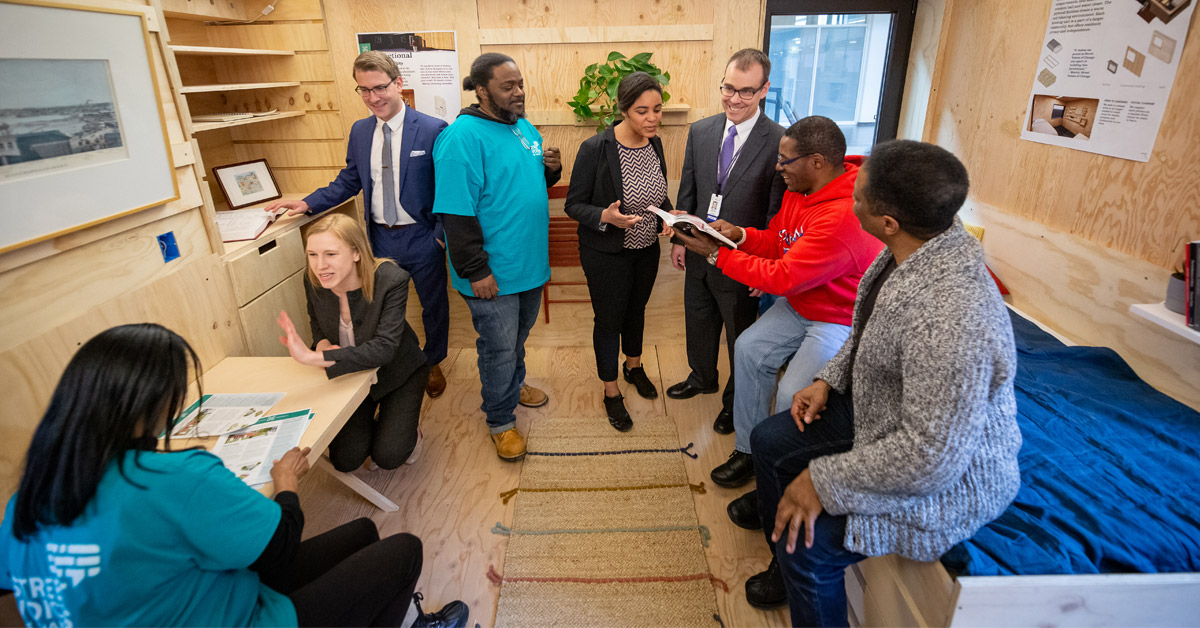Two groups have been gathering in Minneapolis to make a bold idea a reality — create an intentional community of “tiny homes” to provide stability and better health for people who do not have a place to live. Street Voices of Change, an organization of those experiencing homelessness, and Upstream Health Innovations, a non-profit dedicated to removing barriers to health, are calling their initiative Envision Community.
Poor mental and physical health can drive people into homelessness. Being homeless can lead to or exacerbate health issues, and, without stable housing, it’s extraordinarily difficult to get better. It’s a profoundly complex public health issue. The majority of care for people who are homeless is delivered via emergency department visits and hospitalizations.
Envision Community will bring together a diverse group of people, including those who have never experienced homelessness, to discover innovative approaches to protecting the health of people who do not have homes.
But several hurdles remain before Envision Community can get up and running, including how to financially support this groundbreaking effort, how to set residence criteria, and how to measure outcomes and success. Exploring those questions was an ideal case study for students in the Master of Healthcare Administration (MHA) program at the School of Public Health, who tackle real-life issues related to health care using the program’s intensive problem-solving method.
Solving problems
The program’s founder James Hamilton formalized the technique in 1946 and it’s practiced by MHA alumni all over the world. Called the “Minnesota Way,” it breaks down nearly any challenge into a series of 14 steps that lead to a greater understanding of the issue. Its most basic premise, and what separates it from other methods, is that problem solving is collaborative.
SPH instructor Justine Mishek leads the problem-solving curriculum taught by a cadre of faculty and alumni experts.
“The number one step in effective problem solving is to take yourself and your ego out of the equation and honor other people’s perspectives,” said Mishek in a recent book about the Minnesota Way.
Last year, Mishek’s students spent spring semester exploring solutions to Envision’s problems and, for the financing question, specifically investigated whether or not health insurance companies, who would benefit from reduced costs for people experiencing homelessness, would invest in the community.
Jumping into the process
After a deep dive into the Envision project to understand its scope and history, the students began working through the problem-solving method’s 14 steps. They interviewed key decision makers from local health plans, such as UCare and Hennepin Health, and worked closely with the Minnesota Council of Health Plans. They talked to government officials and select people from community organizations doing similar work to Envision.
Based on the feedback from these groups, the students began to identify potential solutions and, after final input from the people they originally contacted and the Envision team, they had three recommendations for the organization:
- Although some health care insurance companies around the country have financed similar projects out of their bottom line, Minnesota companies are not ready to do that. The students advice? Envision should begin talking with Hennepin Health and prove that the project is successful in keeping people healthier. Then secure funding from Hennepin Health and work to get buy-in from additional health plans.
- When it comes to selecting residents, Envision should choose people who: qualify for housing support (to help defray costs); are high utilizers of health care services (so the impact of success can be more measurable); and are Hennepin Health members (so the payer can easily track advantages to their cost structure.)
- To monitor health, financial, and social outcomes, use claims data, electronic medical record data, and resident surveys.
The MHA students brought new and critical information to Envision as they explored potential solutions to the group’s funding needs. Impressed with the students’ efforts, the Envision team continues to work closely with the MHA program as it uses its problem-solving technique to help move the community closer to fulfilling its promise. Learn more about Envision Community.
The model
Developed in 1946, the MHA problem-solving method is a technique to bring discipline to critical thinking. Its 14 steps can be followed by anyone, anywhere, and in any situation. Summarized, they are:
- Define the problem or situation (What appears to be the problem may not actually be the problem.)
- Study the problem or situation (Be curious, ask questions, never assume anything.)
- Present your recommendations and a plan of action. (Be prepared to compromise.)
Learn more about the 14 steps of the Minnesota Way.
The impact
Health care management students who use the problem-solving method find that they enter summer internships, fellowships, and new jobs with the tools and confidence needed to effectively start a project, involve stakeholders, observe processes, and work independently. Faculty involved have the chance to connect with local organizations to understand current challenges. Health care organizations and projects can make change using the insights provided by the student teams. Some examples of the technique’s success include: Improving patient care and flow for an ALS (amyotrophic lateral sclerosis) clinic, deploying system-wide telehealth initiatives, and helping a health care start-up expand.
Related Story
Healthy and Homeless = a nearly impossible combination
It is incredibly hard to be healthy if you’re homeless. Staying safe is a constant struggle, as is finding decent food to eat. Medicines are lost or stolen. You can die from the cold or the heat and you’re at higher risk for a variety of diseases, as well as substance use issues.
Read more

